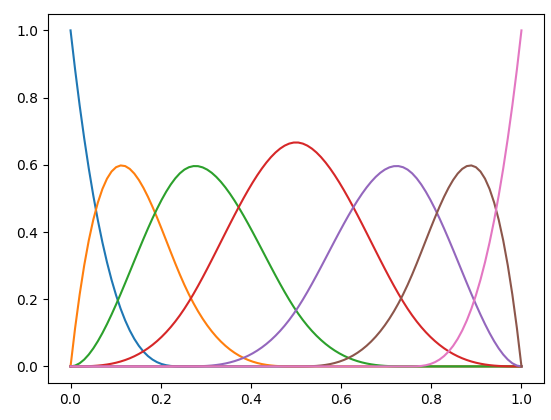In this question I asked the community about how scipy.interpolate.splev calculates a spline basis.. My goal was to compute a spline faster then splev by pre-calculating a bspline basis and generate a curve by doing a basis to control point dot product.
Since then a new scipy.interpolate.BSpline interpolator was added to scipy. It comes with a basis_element function, which I presume could be used to return the basis used to calculate a spline.
So for example using the code from here with the inputs below:
import numpy as np
# Control points
cv = np.array([[ 50., 25., 0.],
[ 59., 12., 0.],
[ 50., 10., 0.],
[ 57., 2., 0.],
[ 40., 4., 0.],
[ 40., 14., 0.]])
kv = [0, 0, 0, 0, 1, 2, 3, 3, 3, 3] # knot vector
n = 10 # 10 samples (keeping it simple)
degree = 3 # Curve degree
I can compute the following bspline basis:
[[ 1. 0. 0. 0. 0. 0. ]
[ 0.2962963 0.56481481 0.13271605 0.00617284 0. 0. ]
[ 0.03703704 0.51851852 0.39506173 0.04938272 0. 0. ]
[ 0. 0.25 0.58333333 0.16666667 0. 0. ]
[ 0. 0.07407407 0.54938272 0.36728395 0.00925926 0. ]
[ 0. 0.00925926 0.36728395 0.54938272 0.07407407 0. ]
[ 0. 0. 0.16666667 0.58333333 0.25 0. ]
[ 0. 0. 0.04938272 0.39506173 0.51851852 0.03703704]
[ 0. 0. 0.00617284 0.13271605 0.56481481 0.2962963 ]
[ 0. 0. 0. 0. 0. 1. ]]
Using np.dot with basis and control points returns 10 samples on curve:
[[ 50. 25. 0. ]
[ 55.12654321 15.52469136 0. ]
[ 55.01234568 11.19753086 0. ]
[ 53.41666667 9.16666667 0. ]
[ 53.14506173 7.15432099 0. ]
[ 53.1882716 5.17901235 0. ]
[ 51.58333333 3.83333333 0. ]
[ 47.20987654 3.87654321 0. ]
[ 42.31790123 6.7345679 0. ]
[ 40. 14. 0. ]]
Question : is it possible to extract the basis as described above out of scipy.interpolate.BSpline?
Obviously I must be using it wrong, because when I try I get something like this:
from scipy.interpolate import BSpline
b = BSpline.basis_element(kv)
print b(np.linspace(kv[0],kv[-1],n)) # i'm not sure what these values represent
[ 0. 0.00256299 0.04495618 0.16555213 0.28691315 0.28691315
0.16555213 0.04495618 0.00256299 0. ]

